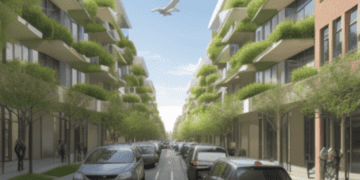A recent study introduces a novel modeling framework emphasizing the significant role of urban greening in mitigating heat and carbon emissions in city environments. Urban vegetation, often affected by unique conditions such as urban heat island effects, elevated CO2 levels, and intensive landscaping, is crucial in managing a city’s carbon dynamics. However, accurately measuring the net CO2 exchange in urban vegetated areas is challenging, complicating the evaluation of urban greening’s environmental benefits.
The WRF-UBC model, designed to assess biogenic CO2 exchange over urban vegetation, considering both meteorological and human-induced changes. Applied to the Chicago Metropolitan Area, the model accounted for urban hydroclimate dynamics and plant phenology. The findings suggest that urban vegetation could offset over half of the region’s on-road emissions during typical summer months. Additionally, the research uncovered that irrigation, while reducing urban heat, also enhances CO2 sequestration.
The study further explored the various factors affecting CO2 flux, highlighting the need for location-specific strategies in implementing nature-based solutions for climate change mitigation and achieving carbon neutrality goals.
This research provides valuable insights into urban carbon accounting and strategies for decarbonization. It also offers guidance for optimizing urban landscaping practices. The findings lay a groundwork for future exploration into urban biogenic carbon dynamics, covering its generation, distribution, and sequestration. This research advances the understanding and implementation of carbon reduction strategies and urban-focused nature-based solutions.
Stay informed with supply chain news on The Supply Chain Report. Free tools for international trade are at ADAMftd.com.
#UrbanGreening #HeatMitigation #CarbonEmissions #UrbanVegetation #ClimateChange #BiogenicCO2 #NatureBasedSolutions #Chicago #Sustainability #Irrigation #UrbanHeatIsland #Decarbonization #EnvironmentalResearch #UrbanLandscaping

















